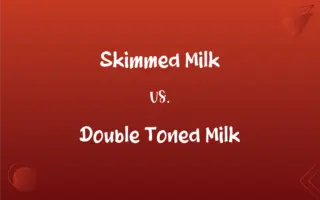Cloning Vector vs. Expression Vector: What's the Difference?
Edited by Aimie Carlson || By Janet White || Published on January 22, 2024
Cloning vector is for DNA replication, while an expression vector is for protein production.

Key Differences
Cloning vectors are DNA molecules used as a vehicle to artificially carry foreign genetic material into another cell, where it can be replicated and/or expressed. The purpose of a cloning vector is to propagate an inserted DNA sequence in a host organism. On the other hand, expression vectors are designed to express the DNA sequence they carry within a host cell, primarily focusing on protein production. The distinction lies in the vector's final objective: replication versus expression.
In terms of design, cloning vectors are equipped with features that ensure the maintenance and replication of the inserted DNA. These include an origin of replication and selectable markers. Expression vectors, however, have additional elements such as promoters, enhancers, and sometimes inducible elements that are crucial for the transcription and translation of the inserted gene into a protein. While both vectors can carry foreign DNA, the expression vector is tailored to convert that DNA into a functional protein.
Cloning vectors are essential tools in molecular biology for gene cloning, where the focus is on generating multiple copies of a DNA sequence. They are often used in the initial steps of genetic engineering. Expression vectors come into play when the goal shifts from mere DNA replication to studying protein functions, producing recombinant proteins, or in gene therapy. They are engineered to ensure efficient gene expression in the chosen host.
Another key difference is in their host range. Cloning vectors can be designed for a broad range of hosts, from bacteria to yeast to plant cells. Expression vectors are often more specific, designed to work efficiently in certain systems like bacterial, yeast, mammalian, or insect cells, depending on the promoter and regulatory sequences they contain. This specificity is crucial for the successful expression of the protein.
The monitoring of inserted genetic material varies. Cloning vectors may contain reporter genes for easy identification of successful cloning. Expression vectors, however, often include tags or reporter genes that not only confirm the presence of the insert but also monitor the level of protein expression. The choice between a cloning and an expression vector depends on the researcher's end goal: DNA replication or protein expression.
ADVERTISEMENT
Comparison Chart
Primary Purpose
DNA replication and propagation
Protein expression and production
Key Features
Origin of replication, selectable markers
Promoters, enhancers, inducible elements
Usage in Research
Gene cloning, DNA sequence analysis
Protein production, gene expression studies
Host Specificity
Broad range (bacteria, yeast, plants, etc.)
Specific (bacteria, yeast, mammalian, insect)
Monitoring Inserted DNA
Reporter genes for cloning confirmation
Tags or reporter genes for expression monitoring
ADVERTISEMENT
Cloning Vector and Expression Vector Definitions
Cloning Vector
A cloning vector is a small piece of DNA into which a foreign DNA fragment can be inserted for cloning purposes.
The scientist used a bacterial cloning vector to replicate the gene of interest.
Expression Vector
An expression vector is a plasmid or virus designed for protein synthesis of a specific gene in a host cell.
The expression vector was crucial in producing the recombinant protein.
Cloning Vector
Cloning vectors serve as vehicles for transferring DNA fragments from one organism to another.
Using a cloning vector, they successfully transferred fish genes into bacterial cells.
Expression Vector
Expression vectors are DNA constructs equipped with all the necessary elements for gene expression.
They utilized an expression vector to study the effects of the gene in human cells.
Cloning Vector
Cloning vectors are DNA sequences that can carry a foreign DNA segment and replicate it within a host cell.
Cloning vectors are fundamental in gene mapping experiments.
Expression Vector
An expression vector is a tool used in biotechnology for the production of proteins from cloned genes.
The therapeutic protein was mass-produced using an advanced expression vector.
Cloning Vector
Cloning vectors are designed to facilitate the easy insertion and replication of specific DNA sequences.
The cloning vector was essential for amplifying the rare DNA fragment.
Expression Vector
An expression vector is used to introduce a specific gene into a cell to produce the corresponding protein.
The gene was cloned into an expression vector to analyze its protein product.
Cloning Vector
A cloning vector is a molecular tool used to duplicate DNA sequences in a host organism.
They introduced the target DNA into a cloning vector for subsequent bacterial transformation.
Expression Vector
Expression vectors contain regulatory sequences that enable the transcription and translation of a specific gene.
To express the foreign gene, it was inserted into an appropriate expression vector.
FAQs
How do cloning vectors differ from expression vectors?
Cloning vectors are for DNA replication, while expression vectors are for protein production.
Can cloning vectors be used for protein production?
Generally, cloning vectors are not designed for protein production; that's the role of expression vectors.
Are expression vectors used in gene therapy?
Yes, expression vectors are often used in gene therapy for the production of therapeutic proteins.
What is a cloning vector?
A cloning vector is a DNA molecule used to replicate a foreign DNA sequence in a host cell.
What are selectable markers in cloning vectors?
Selectable markers in cloning vectors are genes that allow researchers to identify cells that have taken up the vector.
What is an expression vector?
An expression vector is designed to produce a specific protein by expressing a gene in a host cell.
Do expression vectors require specific host cells?
Yes, expression vectors often require specific host cells compatible with their regulatory elements for protein production.
What role do promoters play in expression vectors?
Promoters in expression vectors initiate the transcription of the inserted gene.
What is a host cell in the context of these vectors?
A host cell is the cell into which a cloning or expression vector is introduced for replication or protein production.
Can cloning vectors carry large DNA fragments?
Some cloning vectors are designed to carry large DNA fragments, but there are size limitations.
How are cloning vectors identified in a host?
Cloning vectors are typically identified through reporter genes or antibiotic resistance markers.
What is gene cloning?
Gene cloning is the process of making multiple copies of a specific gene or DNA sequence.
What is gene expression?
Gene expression is the process by which information from a gene is used to synthesize a functional gene product, often a protein.
Can expression vectors be used in animal cells?
Yes, there are expression vectors specifically designed for use in mammalian and other animal cells.
Can expression vectors be used in industrial biotechnology?
Yes, expression vectors are key tools in industrial biotechnology for producing enzymes, pharmaceuticals, and other proteins.
Are cloning vectors only used in bacteria?
No, cloning vectors can be designed for a variety of host organisms, including bacteria, yeast, and plants.
What is an origin of replication in cloning vectors?
The origin of replication is a sequence in cloning vectors that allows them to replicate within a host cell.
Do expression vectors always produce proteins?
Expression vectors are primarily designed to produce proteins, but their efficiency can vary depending on the host and conditions.
How are cloning vectors and expression vectors similar?
Both are types of DNA molecules used in genetic engineering to carry foreign DNA into host cells.
What determines the choice between a cloning vector and an expression vector?
The choice depends on the research objective: DNA replication for cloning vectors and protein expression for expression vectors.
About Author
Written by
Janet WhiteJanet White has been an esteemed writer and blogger for Difference Wiki. Holding a Master's degree in Science and Medical Journalism from the prestigious Boston University, she has consistently demonstrated her expertise and passion for her field. When she's not immersed in her work, Janet relishes her time exercising, delving into a good book, and cherishing moments with friends and family.
Edited by
Aimie CarlsonAimie Carlson, holding a master's degree in English literature, is a fervent English language enthusiast. She lends her writing talents to Difference Wiki, a prominent website that specializes in comparisons, offering readers insightful analyses that both captivate and inform.






































































